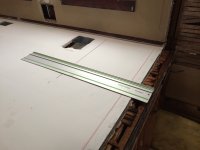We recently moved into a house in which the four walls and ceiling are covered with tongue and groove pine boards. It is just too much wood for us, so we started removing the wood. The first wall at one end of the room was easy. On the side walls the boards meet the vaulted ceiling and many of the wall boards are underneath the ceiling boards and they are difficult to remove because the top of the wall boards are blocked by the ceiling board. I chiseled out a couple of the boards and that became tiresome quickly. There are a lot of boards to remove from the wall and I need to cut about two inches from the top of those boards that are trapped by the ceiling boards so they can be more easily removed.
I tried to get my older Fein 636 Multimaster to work, but the blades keep slipping, a problem I have had with this tool for a long time. I gave up on it.
I don't want to use a larger circular saw because the one I have is heavy and I am doing this standing on a ladder and my first attempt doing this was not comfortable. I need a lighter tool that is easy to adjust/control blade depths so I can cut off about the first couple inches of the wall boards where they meet the ceiling. That will make it easier to get them off the wall.
Any suggestions on a specific tool for this job? Mini circular saw or something else?
Thanks...
I tried to get my older Fein 636 Multimaster to work, but the blades keep slipping, a problem I have had with this tool for a long time. I gave up on it.
I don't want to use a larger circular saw because the one I have is heavy and I am doing this standing on a ladder and my first attempt doing this was not comfortable. I need a lighter tool that is easy to adjust/control blade depths so I can cut off about the first couple inches of the wall boards where they meet the ceiling. That will make it easier to get them off the wall.
Any suggestions on a specific tool for this job? Mini circular saw or something else?
Thanks...



